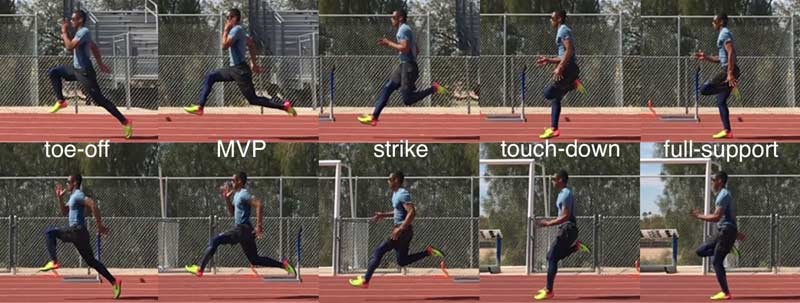The “Kinogram” method used in the Pain Free Powerlifter is based on the trakc and field application developed by the legendary Dan Pfaff and Stuart McMillan at ALTIS.
History of the Kinogram
In the 1880s, Eadweard J. Muybridge pioneered the examination of sprint kinematics and its pictorial representation. He employed cinematographic and dynamographic techniques to study vertical reactions during various gaits (Vazel, 2014).
[](data:image/svg+xml;base64,PHN2ZyBoZWlnaHQ9IjIwMyIgd2lkdGg9IjgwMCIgeG1sbnM9Imh0dHA6Ly93d3cudzMub3JnLzIwMDAvc3ZnIiB2ZXJzaW9uPSIxLjEiLz4=)

Image 1. Eadweard J. Muybridge first examined sprint kinematics and displayed it in pictorial form in the 1880s.
"Chronophotography" soon superseded "cinematography." A "kinogram" is a series of still images derived from a video source. First appearing in 1880s French physiology textbooks, it was later used to describe movement in USSR biomechanics publications in the early 1930s. While often used synonymously with chronophotography, kinograms differ in their flexible frame selection. Chronophotography maintains constant time intervals between frames, whereas kinograms allow for selective frame choice based on relevance (Vazel, 2018).
<aside>
<img src="/icons/arrow-right_red.svg" alt="/icons/arrow-right_red.svg" width="40px" />
A kinogram is a set of still images derived from video, with the most appropriate frames selected.
</aside>
ALTIS coaches employ a five-frame approach—three stance phase frames and two flight phase frames—forming the ALTIS Kinogram Method. The stance phase frames are labeled "touch-down," "full-support," and "toe-off." The flight phases are termed "MVP" (maximal vertical projection) and "strike," marking the point of maximal stretch in the swing-leg hamstring.
[](data:image/svg+xml;base64,PHN2ZyBoZWlnaHQ9IjMwMyIgd2lkdGg9IjgwMCIgeG1sbnM9Imh0dHA6Ly93d3cudzMub3JnLzIwMDAvc3ZnIiB2ZXJzaW9uPSIxLjEiLz4=)

Image 2. These five frames form the ALTIS Kinogram Method. Individual coaches may determine appropriate positions for their athlete group and consider modifications to our recommendations.
We present the following reasons why we believe the kinogram method is an effective tool for movement observation:
- Identify asymmetries and abnormal mechanics: While asymmetries aren't inherently problematic, observing left-right leg differences over time provides coaches with insight into an athlete's typical movement patterns. By establishing an acceptable asymmetry range for each athlete, we can detect when they deviate from their norm. This necessitates consistent, critical movement analysis. Recognising athletes as dynamic systems, we expect day-to-day and week-to-week variability in movement solutions. Our role as coaches is to gradually improve these solutions while ensuring that variability remains within normal limits. This approach keeps athletes healthy by maintaining familiar movement patterns while steadily enhancing them.
- Track mechanical improvement over time: By creating weekly kinograms for each athlete, we can visually represent the progression or regression of their technical model in an easily comprehensible format. While comparing videos over time can be challenging without expensive software, the Kinogram Method, though initially more time-consuming to develop, proves more effective in the long run.
- Compare kinematics across athletes and groups: While respecting individual differences among athletes is crucial, it's equally important to adhere to biomechanical principles. An "athlete-centered" coaching approach doesn't justify ignoring these fundamentals. Comparing across our athlete population or with coaches worldwide enhances our understanding of positions, cause-and-effect relationships, progressions, and individual athlete differences. We encourage coaches to share their kinograms on social media or the private ALTIS Facebook Agora Group to foster discussion.
- Track impact of interventions: Mechanical improvements primarily stem from two sources: the athlete's deliberate effort to incorporate technical changes or enhanced movement efficiency resulting from therapeutic interventions. Regardless of the cause, kinograms offer a simple method to track changes over time, surpassing high-speed video that often requires costly applications.
<aside>
<img src="/icons/arrow-right_red.svg" alt="/icons/arrow-right_red.svg" width="40px" />
A kinogram is a simple way to track changes over time and is much easier than high-speed video.
</aside>
- Improve understanding of key positions and how to influence them: Identifying key positions is one thing; interpreting and using this information to effect change is another. Still frames make it easier for coaches to spot irregular positions compared to real-time observation or video review. While coaches should hone their observational skills, kinograms can serve as a bridge, providing context for important positions.
- Gain a better understanding of individual athlete solutions: With time, coaches become familiar with inter-group variations. As the kinogram process is repeated with each athlete, coaches develop a deeper understanding of each athlete's unique mechanics.


